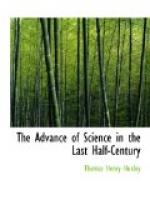The application of the generalisations of thermotics to the problem of the duration of the earth, and of deductions from tidal phenomena to the determination of the length of the day and of the time of revolution of the moon, in past epochs of the history of the universe; and the demonstration of the competency of the great secular changes, known under the general name of the precession of the equinoxes, to cause corresponding modifications in the climate of the two hemispheres of our globe, have brought astronomy into intimate relation with geology. Geology, in fact, proves that, in the course of the past history of the earth, the climatic conditions of the same region have been widely different, and seeks the explanation of this important truth from the sister sciences. The facts that, in the middle of the Tertiary epoch, evergreen trees abounded within the arctic circle; and that, in the long subsequent Quaternary epoch, an arctic climate, with its accompaniment of gigantic glaciers, obtained in the northern hemisphere, as far south as Switzerland and Central France, are as well established as any truths of science. But, whether the explanation of these extreme variations in the mean temperature of a great part of the northern hemisphere is to be sought in the concomitant changes in the distribution of land and water surfaces of which geology affords evidence, or in astronomical conditions, such as those to which I have referred, is a question which must await its answer from the science of the future.
[Sidenote: Biological sciences.]
[Sidenote: The ‘cell theory.’]
Turning now to the great steps in that progress which the biological sciences have made since 1837, we are met, on the threshold of our epoch, with perhaps the greatest of all—namely, the promulgation by Schwann, in 1839, of the generalisation known as the ‘cell theory,’ the application and extension of which by a host of subsequent investigators has revolutionised morphology, development, and physiology. Thanks to the immense series of labors thus inaugurated, the following fundamental truths have been established.
[Sidenote: Fundamental truths established.]
All living bodies contain substances of closely similar physical and chemical composition, which constitute the physical basis of life, known as protoplasm. So far as our present knowledge goes, this takes its origin only from pre-existing protoplasm.
All complex living bodies consist, at one period of their existence, of an aggregate of minute portions of such substance, of similar structure, called cells, each cell having its own life independent of the others, though influenced by them.
All the morphological characters of animals and plants are the results of the mode of multiplication, growth, and structural metamorphosis of these cells, considered as morphological units.
All the physiological activities of animals and plants—assimilation, secretion, excretion, motion, generation—are the expression of the activities of the cells considered as physiological units. Each individual, among the higher animals and plants, is a synthesis of millions of subordinate individualities. Its individuality, therefore, is that of a ‘civitas’ in the ancient sense, or that of the Leviathan of Hobbes.




